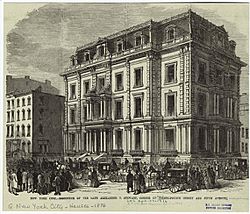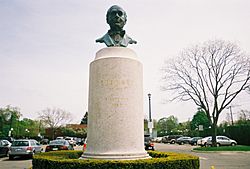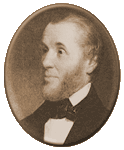Alexander Turney Stewart facts for kids
Quick facts for kids
Alexander Stewart
|
|
|---|---|
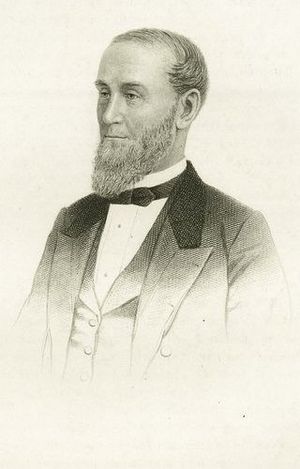 |
|
| Born |
Alexander Turney Stewart
October 12, 1803 |
| Died | April 10, 1876 (aged 72) |
| Education | Belfast Academical Institution |
| Political party | Republican |
| Spouse(s) |
Cornelia Mitchell Clinch
(m. 1823) |
Alexander Turney Stewart (born October 12, 1803 – died April 10, 1876) was a very successful businessman from America. He moved to New York City and became incredibly rich. He made his money from the biggest and most profitable dry goods store in the world.
Stewart was born in Lisburn, Ulster, Ireland. He first wanted to become a minister. But in 1823, he decided to move to New York City instead. He taught for a short time. Then he went back to Ireland to get money his grandfather had left him. With this money, he bought Belfast linens and laces. He returned to New York to open his own store.
Stewart was amazing at business. By 1848, he had built a huge store with a marble front. It was on Broadway between Chambers Street and Reade Street. This store was for selling goods in bulk to other businesses. In 1862, he built an even bigger store. It covered a whole city block between Broadway and Fourth Avenue, and 9th and 10th streets. This new store was eight stories tall. It amazed wealthy people in New York and drew them in to shop. Rich customers even came by train from other cities just to visit his store.
Stewart earned most of his money from selling goods in bulk. He also made a lot from real estate in New York City. He opened branches of his company in other parts of the world. He also owned several mills and factories. In 1863, he had a yearly income of about US$1.8 million. This would be like $32.3 million today. Experts believe he was one of the twenty wealthiest people in history. His fortune was worth about US$90 billion in 2012.
Contents
Stewart's Early Life and Education
Alexander Turney Stewart was born in Lisburn, Ireland, on October 12, 1803. His parents were Scottish Protestants. Just three weeks after he was born, Stewart's father, a farmer, died from tuberculosis. About two years later, Stewart's mother remarried. She moved to America with her new husband. Stewart stayed behind and was raised by his grandfather, John Torney.
John Torney wanted his grandson to become a minister. When Stewart was seven, he started school in a village. In 1814, he went to Mr. Neely's English Academy. Stewart's grandfather died in 1816. After that, Stewart lived with Thomas Lamb, an Irish Quaker.
Stewart finished his schooling at Royal Belfast Academical Institution. He then wrote to his mother in New York City. He wanted to move there. But Mr. Lamb convinced the fifteen-year-old Stewart to get some business experience first. So, Stewart worked as a grocer in Belfast. He quickly got tired of this job. In the spring of 1818, Stewart packed his bags. He left for New York with $500 he had earned.
After six weeks at sea, Stewart arrived at his mother's home. He became a tutor at Isaac N. Bragg's Academy. This was a school for rich young people on Roosevelt Street. He earned $300 a year. He also joined an Episcopal church. There, he met Cornelia Mitchell Clinch, who would become his wife. Her father was a wealthy ship supplier.
A. T. Stewart & Company: A Business Empire
We don't know much about Stewart's life between 1818 and 1822. We do know he went back to Ireland. He received money his grandfather had left him, between $5,000 and $10,000.
When he returned to New York City in 1823, Stewart married Cornelia on October 16. Before getting married, Stewart opened his first store. It was at 283 Broadway. He used money from his inheritance and his tutoring job to buy Irish fabrics and local cotton cloths.
The store opened on September 1, 1823. It was across from City Hall Park. It was 12.5 feet wide and 30 feet deep. This was small by today's standards, but normal for the 1800s. A thin wall separated the larger front part for the business from a smaller back part where Stewart lived.
Other dry goods stores were on Pearl Street. But Stewart put his store several blocks west on Broadway. He believed customers would travel to find the best prices. He said the key to success was not where the store was, but how to "obtain wholesale trade to undersell competitors."
When he first opened, Stewart put cases of goods on the sidewalk. This was his way of advertising. He said the "messy clutter in front of the store and pushing crowds advertised the business."
As he became a top retailer, Stewart didn't put signs on his store. He also didn't advertise until May 13, 1831. He felt that anyone who wanted to shop there would "know where it was located."
Stewart was a natural salesman. He knew that to build a great business, you had to make friends with customers. He focused on good customer service. He wanted customers to be happy and satisfied so they would come back.
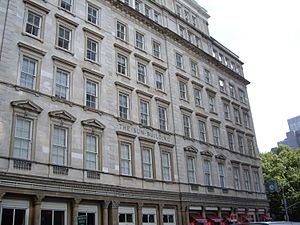
Between 1846 and 1848, Stewart built one of his most famous buildings. It was called the "Marble Palace" at 280 Broadway. This store helped A. T. Stewart & Company become one of America's most successful retailers. It was known as "the cradle of the department store".
The building is still at 280 Broadway. It was originally four stories tall. It sold imported European women's clothing. On the second floor, they had the first women's "fashion shows." Full-length mirrors let women see themselves from all angles.
The building had an Italianate design. It was covered with Tuckahoe marble. It was the first commercial building in the U.S. to look so fancy on the outside. Inside, Stewart wanted to show off his goods. He also wanted a lot of natural light from the building's central dome and high ceilings.
The "Marble Palace" was one of the first "big stores" to sell many different items. It was a huge financial success. By 1855, Stewart's personal wealth was about $2.25 million. In 1856, he started selling furs. He told customers they were "the best and most natural skins." In the 1850s, he also moved his business to an area called "Ladies' Mile." Other big stores like Macy's and Lord and Taylor were there too.
In 1862, Stewart built his "true" department store. It was called the "Iron Palace." This six-story building had a cast-iron front and a glass dome skylight. It was a grand shopping center. Up to 2,000 people worked there. The huge building covered a large part of a city block. It was near Grace Church, from Broadway and Ninth Street to Tenth Street and Astor Place. The store had nineteen departments. They sold things like silks, dresses, carpets, and toys.
By 1877, it had grown to thirty departments. It carried a wide variety of items. The New York Times newspaper said that "a man may fit up his house there down to the bedding, carpets and upholstery."
The Iron Palace building was later taken over by other companies. It was bought by Wanamaker's department store in 1896. Sadly, it burned down in 1956.
Mail Order Business: Shopping from Home
A. T. Stewart & Company became well-known across the country. Stewart was one of the richest men in the United States. He also let women all over the country buy items from his wholesale store by mail.
Starting in 1868, Stewart began getting letters from women in rural areas. They wanted to order his goods. Stewart quickly sent them the products they asked for. He even paid for the postage. Once they received their orders, the women would send him the payment.
Stewart saw how much potential the mail order business had. By 1876, he had hired twenty clerks. Their job was to read, reply to, and mail out orders. That year, he made over $500,000 just from the mail-order business. Stewart's mail-order business was so efficient and convenient. Its success caught the attention of other famous businesses. Companies like Sears, Montgomery Ward, and Spiegel's later started their own mail-order services.
Stewart's Fifth Avenue Mansion
In 1869 and 1870, A. T. Stewart built one of the first grand mansions on Fifth Avenue. It was on the northwest corner of 34th Street. It was across from the home of Caroline Schermerhorn Astor, a very important person in New York society. His architect, John Kellum, also designed his store. While most homes on Fifth Avenue were brownstone houses, Stewart's mansion was fireproof. It was built in the French Second Empire style and covered with marble.
It had three main floors and an attic with a mansard roof. A middle floor was used for storage. The house had a moat-like space around it. This let light into the basement service areas. The main living room stretched the entire length of the house facing Fifth Avenue.
After Stewart's wife died in 1886, the mansion was rented out. It became the home of the Manhattan Club. The building was torn down in 1901. A new building for the Knickerbocker Trust Company was built there.
Central Railroad and Garden City
Stewart started the Central Railroad of Long Island in 1871. It was finished in 1873. The railroad ran from Long Island City through his new town, Garden City. It went to a brick factory in (Old) Bethpage and docks in Babylon. This railroad became part of the Long Island Rail Road system in 1876. Parts of it are still used today.
Stewart's Legacy and Final Years
Before Stewart died in 1876, he had built his own factories. He wanted his own mills to supply his stores. These mills were in New York and New England. Stewart made his own woolen fabrics there and employed thousands of workers. Stewart also served on several New York State Chamber of Commerce Committees. He attended Abraham Lincoln's funeral as a representative for the Chamber.
Before his death, he was building a village called Garden City on Hempstead Plains, Long Island. He wanted to provide comfortable and affordable homes for his employees. After he died, his wife Cornelia built several buildings to honor him. These included St. Paul's School and The Cathedral of the Incarnation, Garden City. The Cathedral also became a burial place for both Stewart and his wife.
Stewart died as one of the richest men in New York. He was worth an estimated $50 million. Only a Vanderbilt and an Astor were richer. Unlike other wealthy New Yorkers who made money from real estate, Stewart earned his fortune in retail. Out of the twenty-four clerks who started at A. T. Stewart & Company in 1836, six still worked there in 1876. Stewart showed his thanks to these long-term employees. He left them more than $250,000 in his will. This would be like $7,000,000 today.
Stewart's body was stolen from its tomb in November 1878. This happened about two and a half years after he was buried at St. Mark's Church in-the-Bowery. The people who stole his body demanded $20,000 for its return. The money was paid, and the remains were returned. However, it was never fully proven that they were his. A local story says that the building where his remains are kept has security devices. These devices will make the Cathedral bells ring if anyone tries to disturb the tomb.
After Stewart's death, his huge fortune faced many legal challenges. His wife, Mrs. Stewart, lived quietly in New York. She also inherited the Grand Union Hotel in Saratoga Springs, New York. She died in 1886.
In 1896, the Iron Palace was bought by John Wanamaker. He reopened it as "Wanamaker's". Wanamaker admired Stewart greatly. He said one of Stewart's best qualities was his "personal attention to the details of the business." He meant that Stewart paid attention to everything, even small things. In 1917, the New York Sun newspaper bought Stewart's Marble Palace for its main offices. In 1966, the building was named a landmark by New York City.
See also
- Stewart's was an unrelated, now-defunct, Baltimore, Maryland-based chain of department stores
- Stewart Dry Goods an unrelated now-defunct Louisville, Kentucky chain
- A. T. Stewart (pilot boat) the name of this boat was nominated by the friends of Mr. Stewart
Images for kids



